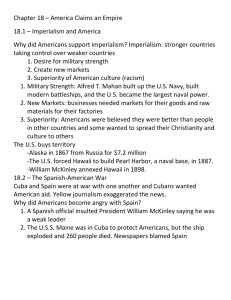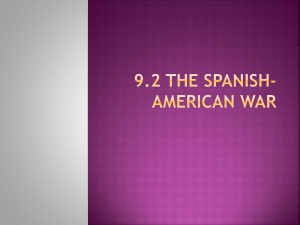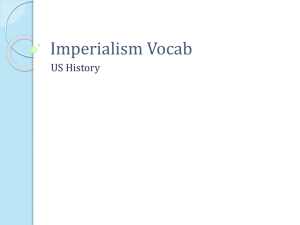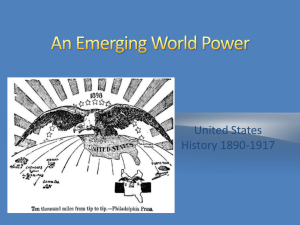Chapter 18 – America Claims an Empire
advertisement
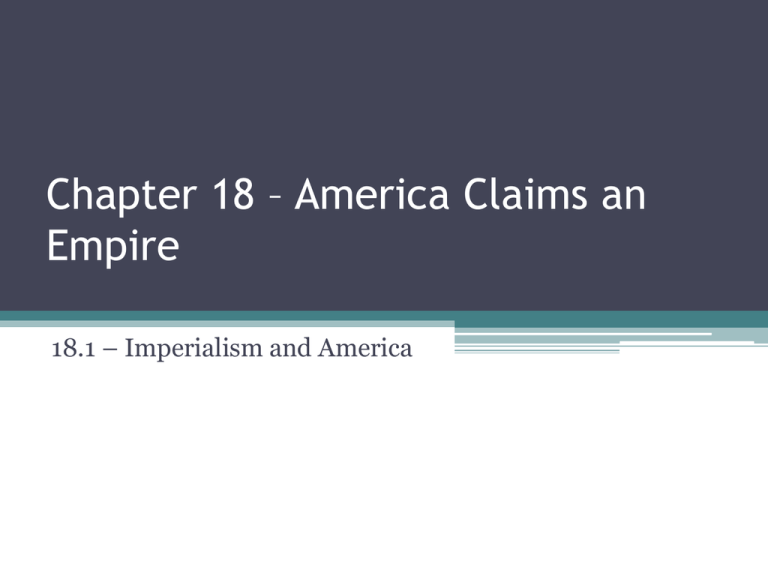
Chapter 18 – America Claims an Empire 18.1 – Imperialism and America Why did Americans support imperialism? • Imperialism: stronger countries taking control over weaker countries • Desire for military strength • Create new markets • Superiority of American culture (ethnocentrism) Bell Ringer: 1. What do you see in this picture? 2. What do you think this picture is showing or representing? • Military Strength: Alfred T. Mahan built up the U.S. Navy, built modern battleships, and the U.S. became the largest naval power. • New Markets: businesses needed markets for their goods and raw materials for their factories • Superiority: Americans were believed they were better than people in other countries and some wanted to spread their Christianity and culture to others The U.S. buys territory • Alaska in 1867 from Russia for $7.2 million • -The U.S. forced Hawaii to build Pearl Harbor, a naval base, in 1887. • -William McKinley annexed Hawaii in 1898. 18.2 – The Spanish-American War • Cuba and Spain were at war with one another and Cubans wanted American aid. Yellow journalism exaggerated the news. Why did Americans become angry with Spain? • A Spanish official insulted President William McKinley saying he was a weak leader • The U.S.S. Maine was in Cuba to protect Americans, but the ship exploded and 260 people died. Newspapers blamed Spain War with Spain erupted on April 1898. • First battle was in the Philippines – a Spanish colony for 300 years • In May, an American naval commander sailed to the Philippines and destroyed the Spanish fleet. • For the next 2 months, U.S. soldiers fought on the side of Filipino rebels. • Spanish surrendered to the U.S. in August in the Philippines. Cuba • In Cuba, the U.S. blocked off a harbor and Spanish ships couldn’t leave. • Volunteer soldiers, called the “Rough Riders,” helped win the battle of San Juan Hill. • The Spanish surrendered on July 25 in Cuba. The Treaty of Paris was signed • Cuba became independent • Spain gave Puerto Rico and Guam to the U.S. • The U.S. bought the Philippine Islands for $20 million • Americans had mixed feelings about imperialism 18.3 – Acquiring New Lands • How did Puerto Ricans feel about U.S. control? • -Resented them because U.S. military officials insulted them and limited their freedom. • -The Foraker Act ended military rule and set up a civil government • -In 1917, Congress made Puerto Ricans U.S. citizens How did the U.S. keep control over Cuba? • -Cuba was independent, but the U.S. army stayed there for 4 years • -Cubans wrote a constitution and the U.S. insisted they add the Platt Amendment • Platt Amendment: Limited Cuba’s rights when dealing with other countries and gave the U.S. special privileges. • -Cuba became a U.S. protectorate • Protectorate: a country that is controlled by a stronger power Why did the Filipinos rebel against the United States? •Thought the U.S. promised independence; felt betrayed. • -The U.S. won the rebellion and set up a government like Cuba’s What were U.S. interests in China? • -They wanted to trade with China • -Open Door Notes: message sent to other countries to protect U.S. trading rights in China. • -Boxer Rebellion: Chinese rebellion against Western influence, 1900. 18.4 America as a World Power • How did Roosevelt use American power? • Roosevelt became president in 1901 and he used American power to help settle the RussoJapanese War. • Helped build the Panama Canal. • Created a statement called the Roosevelt Corollary: ▫ The U.S. wouldn’t allow Europeans to influence the Western Hemisphere. Why did Woodrow Wilson send troops to Mexico? • He wanted countries to have democratic governments • Mexicans rebelled, but the U.S. sent in troops • In 1917, he took his troops out and Mexico adopted a constitution • Wilson faced a possible war with Europe
